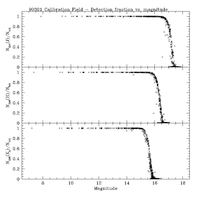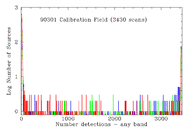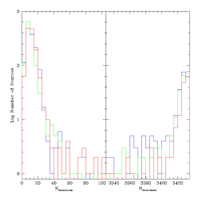


Each extraction in the Survey Point Source Reject Table and 6x and Calibration Point Source Working Databases (PSWDBs) is assigned a reliability score, rel, that is related to the probability that the extraction is a detection of a real astrophysical source at the time of the 2MASS observation. The reliability score is a single character with a value A-F that maps into a probability range according to Table 1.
The algorithm for assigning the
reliability score to point source
extractions is developed using a large "truth table"
of WDB extractions with independently determined reliability to
examine how fractional reliability of the ensemble changes
with source parameters such as brightness,
signal-to-noise ratio (SNR)
and band-detection combinations. The empirical relationships
between reliability and these parameters are then converted
into a matrix of primary scoring rules that are used in conjunction
with artifact flagging, frame detection statistics and profile-fit
photometry chi-squared thresholds to assign reliability scores
to each point source WDB extraction.
| rel | Probability Range |
|---|---|
| A | P>90% |
| B | 80<P<90% |
| C | 70<P<80% |
| D | 50<P<70% |
| E | 20<P<50% |
| F | P<20% |
The "truth table" used for the point source reliability parameterization was generated from the set of extractions in the Survey Point Source Working Database (PSWDB) that fall within the areas covered by the 2MASS calibration tiles. The reliability of each extraction in the truth table is determined using detection statistics from the hundreds to thousands of independent scans of each calibration tile (i.e. how many times a source was detected out of how many times it was observed). The truth table was constructed as follows:
The net reliability for an ensemble of truth table extractions is given by the ratio of the number of reliable extractions (Nrel) to the total number of extractions (Ntot=Nrel+Nunrel):
Figures 4 and 5 shows the histograms of the number of reliable and unreliable truth table sources as a function of magnitude and photometric measurement uncertainty bins from four high latitude calibration fields (90301 - 3430 scans, 90266 - 2776 scans, 90272 - 1973 scans, and 90330 - 1192 scans), where source reliability has been classified as described above. Real sources are shown in black and spurious extractions in red.
The magnitude at which a particular sensitivity is achieved in the 2MASS observations can vary by nearly one magnitude because of variations in atmospheric seeing, background and throughput conditions (see VI.2). Consequently, photometric measurement uncertainty (or equivalently SNR) is a better parameter by which to characterize reliability than magnitude. Figure 6 shows the differential net reliability distribution as a function of photometric uncertainty derived from the distributions in Figure 5.
Figures 7-11 show the dependence of reliability on photometric uncertainty derived using the Survey PSWDB truth table extractions in all of the 2MASS calibration fields for different band-detection combinations. Figure 7 shows the reliability for 3-band detections, Figures 8-10 show 2-band detections (JH, JKs, Hs, respectively), and Figure 11 shows reliability for single-band detections. In each figure, the top panel shows the net reliability curves, with J-band shown in blue, H-band in green and Ks-band in red. The bottom three panels in each figure show log histograms of real (black) and spurious (magenta) source counts in the three bands as function of photometric uncertainty.
The 3-band detection reliability curve shown in Figure 7 indicates that extractions with valid J, H and Ks are virtually always real, independent of source SNR. Low SNR extractions in one band are frequently accompanied by a higher SNR extraction in another band that "pull-up" their net reliability. Two-band detections are also highly reliable up to an uncertainty of msig~0.2 mag (SNR~5), for the same reason. However, 2-band-detected extraction reliability decreases systematically towards lower SNR values. Single-band detections have the poorest overall reliability in the Survey PSWDB, and their net reliability also declines rapidly with decreasing SNR. J-band-only detections are the most common real single-band sources because the survey's instrumental response was highest in the J-band and the atmospheric backgrounds are lowest. This is augmented by the fact that the majority of sources detected by 2MASS are Milky Way stars, most of whose spectra decline between 1.2 and 2.2 microns.
Other attributes assigned to point source extractions during
pipeline data reduction are effective means to identify
unreliable detections, and are incorporated into the
WDB reliability scoring. These include artifact
flagging, frame detection statistics,
and for non-saturated sources, the chi-squared
goodness-of-fit parameter
from point source profile-fitting photometry, and all were used to
filter out unreliable sources during construction of the
All-Sky PSC and 6x-PSC, as described in V.3 and
A3.6.c. See also the
description of the attributes of unreliable sources found in
the 2MASS All-Sky PSC in I.6.b.vi.
The reliability score for point source WDB extractions was determined initially using the number of bands-detected, the photometric uncertainty (and SNR), and artifact flagging. The initial score was then revised if the extraction possesses characteristics of known spurious detections (e.g. residual cosmic rays, meteor trails, hot pixels, edge flares, etc). Note that because reliability is determined as a function of photometric measurement uncertainty/SNR rather than measured flux, the same relationships can be used for the Survey/Calibration PSWD and the 6x PSWDB extractions.
For the purposes of reliability scoring, an extraction is considered to be detected in a band only if rd_flg MATCHES '[123]' in that band. If an extraction has no valid detections in any band, then it is assigned a reliability score of rel='F'.
i. Initial Score
3-Band Detections
1- and 2-Band Detections
2-Band Detections: JH detections rel A B C D E F J: snr >4.53 >4.18 >3.88 >3.50 >3.19 <3.19 cmsig <0.24 <0.26 <0.28 <0.31 <0.34 >0.34 H: snr >4.18 >3.88 >3.62 >3.39 >3.19 <3.19 cmsig <0.26 <0.28 <0.30 <0.32 <0.34 >0.34 HKs detections rel A B C D E F H: snr >5.17 >4.52 >4.18 >3.88 >3.50 <3.50 cmsig <0.21 <0.24 <0.26 <0.28 <0.31 >0.31 Ks:snr >5.17 >4.52 >4.18 >3.88 >3.50 <3.50 cmsig <0.21 <0.24 <0.26 <0.28 <0.31 >0.31 JKs detections rel A B C D E F J: snr >5.43 >4.52 >4.18 >3.88 >3.50 <3.50 cmsig <0.20 <0.24 <0.26 <0.28 <0.31 >0.31 Ks:snr >4.72 >4.34 >4.02 >3.74 >3.39 <3.39 cmsig <0.23 <0.25 <0.27 <0.29 <0.32 >0.32 1-Band Detections rel A B C D E F J: snr >7.76 >6.03 >5.43 >4.94 >4.94 <4.94 cmsig <0.14 <0.18 <0.20 <0.22 <0.25 >0.25 H: snr --- >7.24 >6.39 >5.43 >4.34 <4.34 cmsig --- <0.15 <0.17 <0.20 <0.25 >0.25 Ks:snr --- >9.87 >7.24 >6.03 >4.94 <4.94 cmsig --- <0.11 <0.15 <0.18 <0.22 >0.22 (Note - Best reliability score for H-only and Ks-only sources is "B")
Extractions with no valid detections
ii. Final Score Revision
For 1- and 2-band detections that do not already have an initial reliability score of rel='F', set rel='F' if any of the following conditions are met. These conditions are derived from quality criteria developed as part of source selection for the All-Sky PSC:
rd_flg NOT MATCHES '*[1,3]*' AND rd_flg[b] = '2' AND [jhk]_cmsig > 0.1 AND [jhk]_psfchi > 2 (in all detected bands)
rd_flg NOT MATCHES '*[1,3]*' AND ndet[2,4,6] < 3 (in all detected bands)
rd_flg NOT MATCHES '*[1,3]*' AND
(j_m < 14.5 and ndet[1]/ndet[2] < 0.41 (if J-band detection) AND
h_m < 14.0 and ndet[3]/ndet[4] < 0.41 (if H-band detection) AND
k_m < 13.5 and ndet[5]/ndet[6] < 0.41 (if Ks-band detection)
Note - The magnitude limits used for 6x point source WDB are:
15.9 (J), 14.8 (H), 14.4 (Ks)
This is the only magnitude-dependence used in the point
source reliability assignment.
[Last Update: 2006 October 1, by R. Cutri]